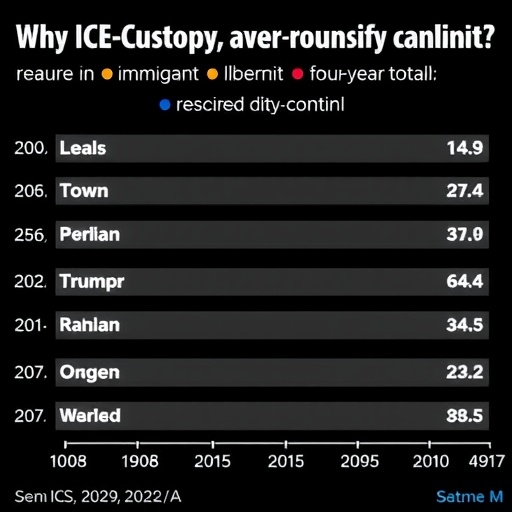ICE custody Deaths Surge Under Trump: 20 Immigrant Lives Lost in 10 Months, Nearing Biden’s Four-Year Total
In a stark escalation of the immigration crisis, U.S. Immigration and Customs Enforcement (ICE) reports 20 deaths of undocumented immigrants in custody within the first 10 months of the Trump administration, a figure that nearly matches the total recorded during President Biden’s entire four-year term. This surge has ignited fierce debates over border policy and the conditions in detention centers, as advocates demand immediate reforms to prevent further tragedies.
- Detention Center Tragedies: Unpacking the 20 Fatalities
- Trump’s Border Policy: Acceleration of Enforcement and Its Deadly Consequences
- Healthcare Shortages Exposed: Inside the Crisis in ICE Facilities
- Advocates Rally: Demands for Reform Amid Mounting Pressure
- Path Forward: Balancing Security and Humanity in Immigration Enforcement
Detention Center Tragedies: Unpacking the 20 Fatalities
The grim milestone of 20 deaths in ICE custody under the Trump administration highlights a troubling pattern in America’s immigration enforcement system. According to official ICE data released this week, these fatalities include cases of medical neglect, suicides, and untreated chronic illnesses among detainees held in facilities across the Southwest border and beyond. For context, during Biden’s presidency from 2021 to 2025, ICE recorded 22 such deaths over four full years—a pace that the current administration has nearly equaled in less than a year.
Experts attribute much of this rise to the intensified border policy measures implemented since January 2025, including expanded raids and rapid deportations that have overwhelmed detention centers. One particularly heartbreaking case involved Maria Gonzalez, a 34-year-old mother from Honduras who died from complications of untreated diabetes while held at the Eloy Detention Center in Arizona. Her family, speaking through advocates, described how pleas for medical attention went unheeded for weeks. “She was scared and alone, begging for help that never came,” said her sister, Rosa Gonzalez, in an emotional statement to reporters.
Statistics paint an even bleaker picture. The Department of Homeland Security (DHS) notes that overcrowding in detention centers has reached 120% capacity in key facilities like those in Texas and California, leading to delayed medical screenings and inadequate healthcare. A 2024 Government Accountability Office (GAO) report, predating the current surge, already warned of systemic failures in ICE custody, including insufficient staffing and poor record-keeping on detainee health. Now, with immigration deaths climbing, calls for accountability are louder than ever.
Breaking down the demographics, the 20 victims include 12 men, 7 women, and 1 non-binary individual, with ages ranging from 19 to 62. Causes of death vary: eight from natural causes exacerbated by neglect, five suicides linked to mental health crises, and seven from infectious diseases like COVID-19 variants that spread rapidly in confined spaces. This data underscores the human cost of stringent border policy, where undocumented immigrants caught in the crosshairs of enforcement face dire risks in ICE custody.
Trump’s Border Policy: Acceleration of Enforcement and Its Deadly Consequences
President Trump’s return to the White House has ushered in an aggressive border policy agenda, promising to “secure the border like never before.” Executive orders issued in his first month expanded ICE operations, authorizing more interior enforcement and family separations in some cases, echoing policies from his first term. However, this renewed focus on deterrence has correlated directly with the spike in immigration deaths.
Under the Trump administration, daily detention numbers have ballooned to over 50,000—up from 34,000 at the end of Biden’s term—straining resources in detention centers nationwide. Border Patrol apprehensions surged by 45% in the first quarter of 2025 alone, fueled by migrants fleeing violence in Central America and economic instability. Critics argue that this policy prioritizes volume over safety, leading to hasty detentions without proper health assessments.
“The administration’s zero-tolerance approach is putting lives at risk,” stated Tom Homan, former acting ICE director and a Trump appointee, in a recent interview with CNN. Ironically, even supporters of tough enforcement acknowledge the humanitarian fallout. Homan added, “We need to enforce the law, but not at the expense of basic human dignity.”
Historical comparisons reveal the policy’s impact. During Trump’s first term (2017-2021), ICE custody saw 21 deaths, a number that drew widespread condemnation and led to lawsuits from groups like the ACLU. Biden’s administration, aiming for a more humane approach, reduced fatalities through expanded parole programs and virtual hearings, yet still faced 22 deaths amid ongoing challenges like the pandemic. Now, the Trump administration’s border policy—bolstered by wall expansions and military deployments—appears to be reversing those gains, with immigration deaths accelerating at an alarming rate.
Furthermore, funding allocations tell a story of misplaced priorities. The 2025 budget proposes $25 billion for border security, including new detention centers, but only a fraction for healthcare improvements. This imbalance, say policy analysts, exacerbates conditions in existing facilities, where basic amenities like clean water and prompt medical care are often lacking.
Healthcare Shortages Exposed: Inside the Crisis in ICE Facilities
At the heart of the immigration deaths crisis lies a profound shortage of medical personnel in ICE custody. Detention centers, designed for temporary holding, are ill-equipped to handle the chronic health issues prevalent among long-term detainees—conditions like hypertension, mental illness, and tuberculosis that require ongoing care.
A whistleblower report from a nurse at the Otay Mesa Detention Center in San Diego, leaked to The New York Times, details how one doctor serves 1,500 detainees, far exceeding American Medical Association guidelines. “We’re triaging emergencies while ignoring preventive care,” the anonymous nurse wrote. “It’s a recipe for disaster.” This scarcity has directly contributed to several of the 20 fatalities, including a 28-year-old Guatemalan man who succumbed to a treatable heart condition after repeated requests for an EKG were denied due to staffing constraints.
In response, the Trump administration announced plans to recruit 500 additional healthcare workers for ICE facilities, a move touted by DHS Secretary Kristjen Nielsen in a press briefing. “We’re committed to improving conditions,” Nielsen said. “These hires will ensure better monitoring and faster interventions.” However, advocates dismiss this as a band-aid solution. The American Immigration Council estimates that true reform would require at least 2,000 new staffers, plus mandatory accreditation for all detention centers under standards similar to those for prisons.
Looking at past efforts, Biden’s administration invested $300 million in detainee health during 2023, implementing telehealth programs that reduced mortality by 15%. Yet, under Trump, such initiatives have been scaled back in favor of enforcement funding, leading to a reversion in safety protocols. Infectious disease experts warn that without addressing these gaps, outbreaks could mirror the 2020 COVID-19 crisis in detention centers, where over 10,000 cases were reported.
Personal stories amplify the urgency. Jose Ramirez, a detainee released after his wife’s death in custody from pneumonia, shared his ordeal with PBS: “They told us the clinic was full. She died waiting for a bed that never came.” These accounts humanize the statistics, revealing the toll of healthcare neglect in the machinery of border policy.
Advocates Rally: Demands for Reform Amid Mounting Pressure
As news of the 20 immigration deaths spreads, advocacy groups are mobilizing with unprecedented vigor. Organizations like the Southern Poverty Law Center and Human Rights Watch have filed lawsuits against ICE, alleging violations of the 8th Amendment’s prohibition on cruel and unusual punishment. “These deaths are not accidents; they’re the result of deliberate policy choices,” declared Maria Estrada, executive director of the Immigrant Defense Project, in a rally outside the White House.
Public outrage has manifested in protests at key detention centers, with demonstrators chanting “Abolish ICE” and calling for congressional oversight. Bipartisan voices are emerging too: Senator Cory Booker (D-NJ) introduced the Dignity for Detained Immigrants Act, which would cap detention lengths at 90 days and mandate independent health audits. Even some Republicans, like Rep. Maria Elvira Salazar (R-FL), have expressed concern, stating in a floor speech, “Enforcement must be tough, but compassionate. We’re failing on the latter.”
International scrutiny adds another layer. The United Nations Human Rights Council issued a statement condemning U.S. practices, citing the surge in ICE custody deaths as evidence of systemic abuse. Mexico’s government, receiving many deportees, has protested the conditions, fearing a public health crisis from untreated illnesses crossing the border.
Media coverage has amplified these calls, with viral videos from inside facilities showing overcrowded cells and desperate pleas for aid. Social media campaigns under hashtags like #EndICEDeaths have garnered millions of views, pressuring the Trump administration to act. Polls from Pew Research indicate 62% of Americans now support healthcare reforms in detention centers, a shift driven by these high-profile tragedies.
Path Forward: Balancing Security and Humanity in Immigration Enforcement
As the Trump administration grapples with this crisis, the road ahead involves tough choices between robust border policy and humane treatment. Upcoming congressional hearings, scheduled for next month, will scrutinize ICE operations, potentially leading to increased funding for medical staff and facility upgrades. The administration’s recruitment drive for healthcare workers could be a starting point, but experts urge broader changes like community-based alternatives to detention, which have proven 80% effective in Biden-era pilots at reducing recidivism and costs.
Long-term, addressing root causes—such as climate-driven migration and cartel violence—through diplomatic efforts with Latin American nations could ease pressure on U.S. borders. The Biden administration’s $4 billion aid package to Central America showed promise in curbing flows; reviving such initiatives might complement Trump’s enforcement goals without the deadly toll.
Ultimately, the surge in immigration deaths serves as a wake-up call. With 20 lives lost in mere months, the nation faces a moral reckoning: Can the pursuit of secure borders coexist with safeguarding those in ICE custody? As reforms unfold, the eyes of the world—and history—watch closely, demanding a system that enforces laws without extinguishing hopes.








